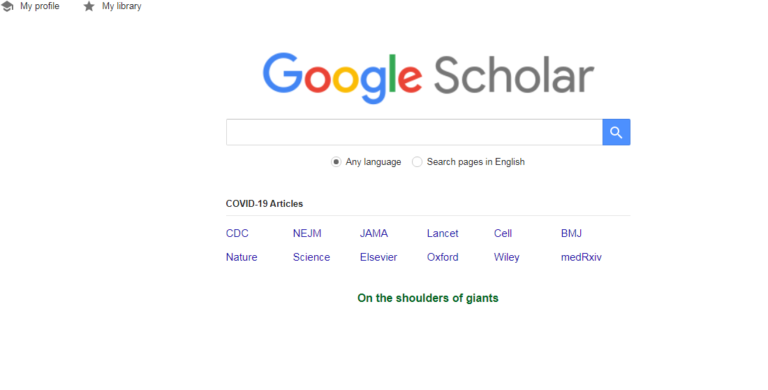Introduction
Till the current date, Google has millions of websites listed in its webmaster and web crawler. And the websites are of all niche so you can easily find answers of any doubt from cooking to engineering machines. But if you are an academic person so it is quite difficult to find a genuine academic article from millions of articles. Hence Google launched Google Scholar or Google Academico from where you can easily find any written academic content in just a few clicks.
About Google Academico
Google Academico is also known as Google Scholar, it is an openly available web internet searcher that lists the full content or metadata of insightful writing over a variety of distributed organizations and controls. Discharged in beta in November 2004, the Google Academico list incorporates most companions looked into online scholastic diaries and books, gathering papers, postulations and papers, preprints, abstracts, specialized reports, and other insightful writing, including court feelings and patents. A prior factual gauge distributed in PLOS ONE utilizing a Mark and recover strategy evaluated roughly 80–90% inclusion of all articles distributed in English with a gauge of 100 million. This gauge additionally decided what number of reports were openly accessible on the web.
Google Academico has been censured for not verifying diaries and for remembering savage diaries for its record.
Note: Google Academico is same as Google Scholar, the only difference is of language. Google Academico is in the Spanish language with the ES domain.
Benefit from Google Scholar with some accommodating tips on the look, email alarms, reference fare, and that’s only the tip of the iceberg.
Discovering late papers
Your indexed lists are normally sorted by significance, not by date. To discover more current articles, attempt the accompanying choices in the left sidebar:
Google Scholar
Google Academico
- Click “Since Year” to show as of late distributed papers, sorted by pertinence;
- Click “Sort by date” to show only the new increases, sorted by date;
- Click the envelope symbol to have new outcomes periodically conveyed by email.
Finding the full content of an article
Digests are uninhibitedly accessible for the majority of the articles. Oh dear, perusing the whole article may require a membership. Here’re a couple of things to attempt:
- Click a library connect, e.g., “FindIt@Harvard”, to one side of the query item;
- Click a connection marked [PDF] to one side of the query output;
- Click “All versions” under the item and look at the elective sources;
- Click “Related articles” or “Cited by” under the item to investigate comparative articles.
In case you’re associated with a college, however, don’t see connections, for example, “FindIt@Harvard”, it would be ideal if you check with your neighborhood library about the most ideal approach to get to their online memberships. You may need to do a hunt from a PC nearby or to design your program to utilize a library intermediary.
Showing signs of improvement answers
- In case you’re new to the subject, it might be useful to get the phrasing from optional sources. E.g., a Wikipedia article for “overweight” may propose a Scholar scan for “pediatric hyperalimentation”.
- In the event that the indexed lists are unreasonably explicit for your requirements, look at what they’re referring to in their “References” areas. Referenced works are frequently progressively broad in nature.
- Likewise, if the query items are unreasonably essential for you, click “Cited by” to see more up to date papers that referenced them. These fresher papers will frequently be progressively explicit.
- Investigate! There’s infrequently a solitary response to an examination question. Snap “Related articles” or “Cited by” to see firmly related work, or quest for the writer’s name and see what else they have composed.
Google Scholar library
Google Scholar library is your own assortment of articles. You can spare articles directly off the hunt page, compose them by point, and utilize the intensity of Scholar search to rapidly discover only the one you need – whenever and from anyplace. You choose what goes into your library, and we’ll stay up with the latest.
You get all the treats that accompany Scholar list items – referring to articles, related articles, designed references, connections to your college’s memberships, and the sky is the limit from there. The best part is that it’s anything but difficult to rapidly top off your library with the articles you need – with a solitary snap, you can import all the articles in your open Scholar profile just as all the articles they refer to.
Frequently Asked Questions
-
How do I add my papers to Google Scholar?
Answer: If you can’t find your papers when you search for them by title and by author, please refer your publisher to Google Scholar’s or Google Academico’s technical guidelines.
You can also deposit your papers into your institutional repository or put their PDF versions on your personal website, but please follow your publisher’s requirements when you do so. See their technical guidelines for more details on the inclusion process.
They normally add new papers several times a week; however, it might take us some time to crawl larger websites, and corrections to already included papers can take 6-9 months to a year or longer.
-
What do you include in Google Scholar and in Google Academico?
Answer: Google Scholar and Google Academico include journal and conference papers, theses and dissertations, academic books, pre-prints, abstracts, technical reports, and other scholarly literature from all broad areas of research. You’ll find works from a wide variety of academic publishers, professional societies and university repositories, as well as scholarly articles available anywhere across the web. Google Scholar also includes court opinions and patents.
-
Which court opinions do you include?
Answer: Currently, Google Scholar and Google Academico allow you to search and read published opinions of US state appellate and supreme court cases since 1950, US federal district, appellate, tax and bankruptcy courts since 1923 and US Supreme Court cases since 1791. In addition, it includes citations for cases cited by indexed opinions or journal articles which allows you to find influential cases (usually older or international) that are not yet online or publicly available.
Legal opinions in Google Scholar are provided for informational purposes only and should not be relied on as a substitute for legal advice from a licensed lawyer. Google does not warrant that the information is complete or accurate.










